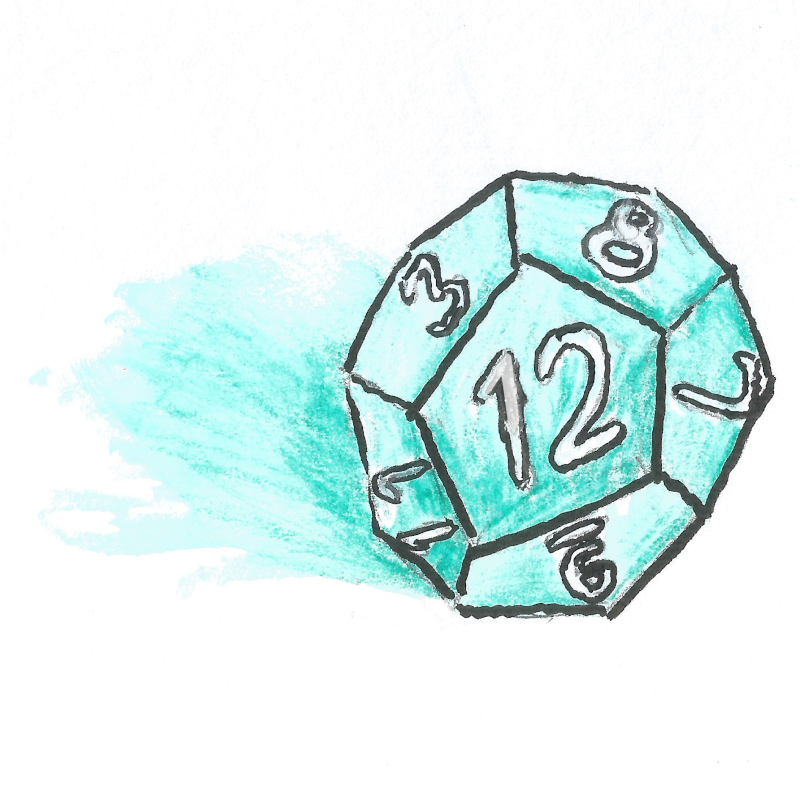When I started GMing long-running TTRPG campaigns again last year, I made a simple decision to add a calendar to the world. It worked out so well I’m always going to do it.
It doesn’t have to be complicated, but I typically follow these rules:
- Pick 12 month names and a year number. You can either ascribe meaning to the year (e.g., “519 IY represents 519 years after the founding of the Empire”), or make it arbitrary (e.g., “1732” with no further explanation.)
- Use the same number of days for each month. I typically use 30 days. Whatever you choose, this ensures you always roll over to the month at the same time. You don’t want to have to remember some complicated “30 days hath September” mnemonic, you want to be able to calculate time periods on the fly.
- The names don’t really matter. You can use evocative names (Brightdawn, Leafsturn, Harvesthome, Baretree, Seedtime, etc.) if you want a particular flavor. The calendar from The Elder Scrolls is a perfect starting place if you’re drawing a blank. But you can keep it simple by starting from another language’s number system (I gave an Imperial calendar names that start with Latin numbers–Unumus, Duous, Tresus, etc.).
- Don’t add too many specifics. The calendar is just for keeping time. You don’t have to attach it to an astronomical model, and it doesn’t have to make sense scientifically. If that’s important to your campaign, you can certainly build a calendar around it. But a simple calendar is one that is easy to track and doesn’t distract from the story.
Having a calendar system lets you do so many neat tricks, essentially for free.
Session note organization
I like to write session notes and post them in a Discord forum after each session. They don’t have to be complicated (you can make do with a bulleted list), but they help everyone (you included) remember what happened last session. I typically skim my notes when I’m giving the recap.
More importantly, session notes create a source of truth, and an opportunity for players to resolve things they remember differently. As the GM, I should not overrule what someone else remembered just because I’m running the game. Providing notes means that other players can see what I remember. If the conflict can’t otherwise be resolved, we can retcon what “really” happened.
You can write session notes without a calendar, but it’s so much easier with one. Each in-game day’s notes are a bulleted list under the date. This also gives a good sense of the flow of time, which is something that’s easy to forget (more on that later).
Seasons
I find it helpful to think about the season of the year when I’m writing descriptive text. The crisp colorful leaves of fall, the powdery snow of winter, the heat of summer, the budding trees of spring–all of these can add texture to your world. For long-running games, the changing seasons can indicate just how much time has passed.
I find it tough to remember season off the top of my head, and even harder to keep track of it changing. By tying seasons to months in the calendar, it’s very easy to tell where you are in the year (if it’s a 12 month calendar, you just match it up to the real-world calendar).
You can also use this for things like moon phases, simply by having your calendar mirror the cycles. For example, you might put the new moon on the 15th and the full moon on the 1st. It’s a minor detail, but it can help you set night scenes by telling the players how much light is available.
Holidays
Holidays are another way to add flavor to your world and its cultures. Once you have a calendar, you can tie in various holidays–either based on the real world, or invented for your own. (For example, I sandwiched a short Obon festival adventure in the Ryuutama game I ran. It was a single-session diversion, but it also provided opportunities to tease the next acts of the story.)
Timelines
When you have multiple NPCs and factions in your world working at related goals, it can sometimes be hard to figure out what’s happening off-screen. With a calendar, you can write out a short summary of key NPC or faction milestones and attach in-game dates to each one.
Timelines should be written around the players’ experience. A timeline only happens if the players don’t intervene; if they do, whatever happens at the table supersedes the timeline. You don’t have to flesh out any particular event on the timeline until players intersect with it.
For example, in my current D&D game, my players hopped off to another plane of the multiverse while trouble was brewing in the material plane. It was a fun sidequest, but I wanted the world to remain in motion while they were away. I wrote out two-and-a-half week timeline where a dark imp broke free and the rivalry between two opposing Imperial factions came to a head. It was too much to keep in my head at once, but a timeline with clean dates simplified it.
